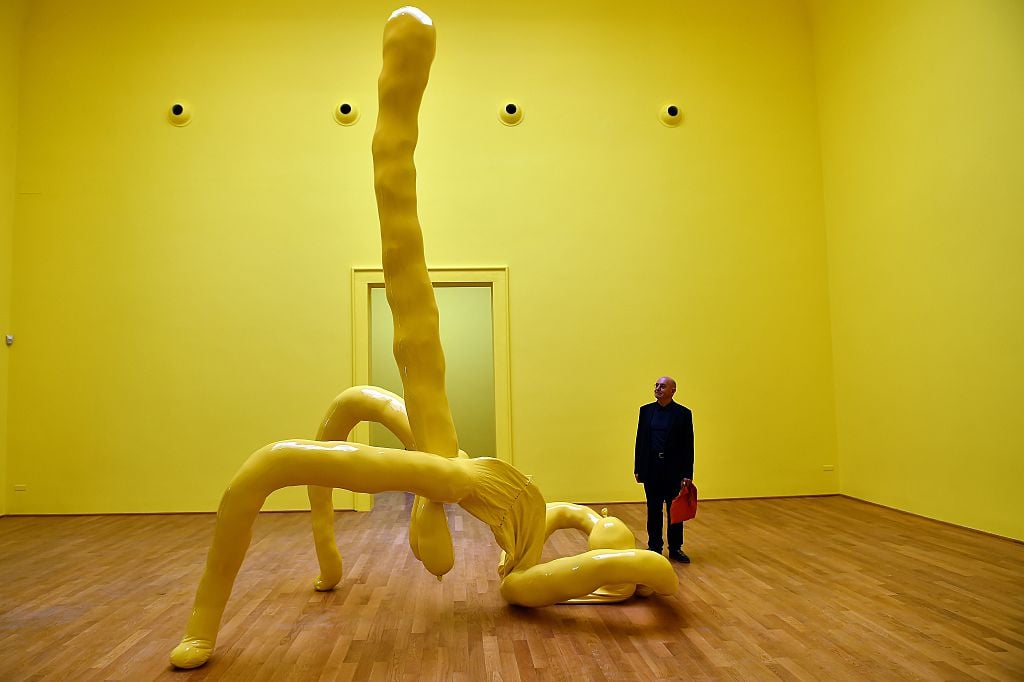
Of all the art exhibitions in the world, our beloved surveys of contemporary art—the biennials, triennials, and sometimes even quinquennials—often feel like they’re designed to overwhelm.
To better understand how to navigate these massive shows, we asked a few curators who’ve organized them to provide tips on how to make sense of the experience.
Let’s start with the practical advice.
Work by Angelica Mesiti in the Australian pavilion at the 58th Venice Biennale in 2019. (Photo by Luca Zanon/Awakening/Getty Images)
Treat It Like a Treasure Hunt
Diana Nawi, the co-artistic director with Naima Keith of last year’s Prospect New Orleans, stressed the importance of having “on-the-ground guidance,” particularly in the form of a map.
“You can almost have a scavenger hunt, and take the map and cross off things venue by venue,” she said.
Keith also encourages viewers to take “a little bit of time, if you have it, to get a slightly better understanding of that local community,” adding that it could go some ways in better understanding “why that work was put up in that area.”
Prem Krishnamurthy, director of the forthcoming Front Triennial in Cleveland, Ohio, uses a similar metaphor.
“Because [Front has] 25 venues across the three cities that you have to drive between, leave yourself time to treat it like a treasure hunt,” he said. “Or treat it like you’re looking for rainbows. You’re out wandering around and if the light is right, you’ll catch something amazing.”
Front has even dedicated part of its website to tools—including a detailed list of events and a map with venues organized by hub location—to help visitors make their plan of attack.
But at some point, the practical stuff gives way to conversations about what visitors should go into these events expecting.
Take your time and enjoy one thing at a time. (Photo by Spencer Platt/Getty Images)
Focus on Singular Experiences
People tend to begin with “the impression that there is actually a way to navigate it all,” said Francesco Bonami, who directed the 50th Venice Biennale in 2003 and the 2010 Whitney Biennial. “And I don’t think there is a way to navigate it.”
“By virtue of their structure, [shows like these are] overwhelming,” Nawi said, adding that Prospect is “the kind of exhibition that is much larger than the two days people usually have for it.”
That means you probably won’t get to see everything.
“Every time you go to the Venice Biennale, you will inevitably meet someone who asks you: ‘Have you seen this thing, or seen this piece?’” Bonami said. “And you will have not seen it.”
This is particularly true, he added, for openings, which he describes as “basically a very self-celebratory moment. At the end of the day, you just feel a sense of exclusion, like you missed a work of art, or you missed a party or something.”
“The beauty of art is that you are the one in charge of your own experience,” Bonami added. So another solution is to organize your time around pre-selected highlights.
When Krishnamurthy does the circuit, he typically “hones in on a handful of key things that I want to make sure that I see, and then I really try to see those and spend time with them.”
Nawi said she had a friend who missed most of a biennial because they spent four hours at a single artist’s performance.
“I feel like that was this really beautiful thing, for them to just stay with it,” she said. “They experienced the entirety of the biennial in front of that performance versus having seen every object.”
The British pavilion at the 2017 Venice Biennale. It was madness. (Photo by Awakening/Getty Images)
Embrace the Madness
Not that you’re guaranteed to miss a lot: not all major art events are spread out over multiple venues.
Since the Whitney Biennial, for example, is housed in one building, “it is more human in scale,” Bonami said. “I think people, maybe, absorb it in a better way than the Venice Biennale.”
Even so, Bonami only expects people to remember a handful of artworks in the end.
So perhaps the very best thing to do is not to devise strategies, but simply to accept the undertaking for what it is.
“The absurdity of the endeavor is so much part of it,” Massimiliano Gioni, who organized the 2013 Venice Biennale, explained. “The fact that people are still congregating periodically to look at art made in 80-plus countries in the world, there is a kind of madness to it. So, I say, embrace the madness.”